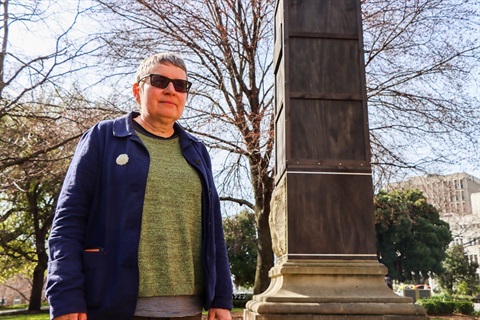Art removes view of controversial statue
Published on 01 September 2021

A controversial statue has been removed from public view through a new temporary artwork at Franklin Square.
The third of four temporary artworks in response to the contentious William Crowther statue – created by local artist Julie Gough – will be unveiled today.
The work, BREATHING SPACE, features the installation of a black timber crate, which covers the bronze figure of William Crowther. In addition, a black panel covers the existing engraved plinth for the statue. A QR code, located on the ground near the work, directs members of the public to a webpage that provides a full-scale, printable amended wording for the plinth.
Julie Gough is an Aboriginal woman from the Briggs family of northern lutruwita/Tasmania. She is nationally and internationally recognised for her artworks that interrogate colonial history on Aboriginal country.
“The memorial statue (of Crowther) overtly celebrates and affirms the colonial project of the dispossession, death, dismemberment of the Aboriginal dead and the taking of Aboriginal lands,” the artist said.
“Encased, crated and covered, the statue of William Lodewyk Crowther and its laudatory plaque is finally, albeit temporarily, removed from view. The man was monstrous. His legacy is Aboriginal grieving that still persists in his and his progenies wake.”
BREATHING SPACE replaces the second artwork in the series, which was a collaboration between Roger Scholes and Greg Lehman and stood beside the Crowther statue.
Deputy Lord Mayor Helen Burnet said the new artwork was a compelling contribution to an arts project designed to encourage public conversation about the future of the William Crowther statue.
“From the beginning of this project, we have aimed to offer a platform to all views, to remain objective and to allow the community to speak,” Cr Burnet said.
“As a result, we have heard many different views from a diverse range of people about how we deal with complex and difficult histories in the city. We look forward to receiving responses from this next iteration by Julie Gough.”
The work has been constructed in a way that it will not damage the existing statue.
Dutch-born William Crowther was a 19th century naturalist and surgeon and briefly Premier of Tasmania but is also known for mutilating the remains of Tasmanian Aboriginal man William Lanne in the 1860s.
Lanne was well regarded as an advocate for his community. The partner of ‘Queen’ Truganini, he became known as King Billy and the native plant the ‘King Billy Pine’ is named after him. He died in 1869, aged 34.
The Crowther Reinterpreted project is delivering four temporary artworks, from solo arts practitioners or small teams of artists, with priority given to Tasmanian Aboriginal artists. The fourth and final instalment will be by Hobart journalist and photographer Jillian Mundy.
The artworks themselves, along with the community feedback and discussion they provoke, will help to inform a permanent response to the statue.
To contribute to the discussion or provide feedback on the artwork, visit yoursay.hobartcity.com.au.